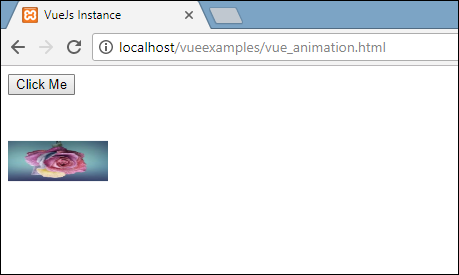
- VueJS 教程
- VueJS - 首頁
- VueJS - 概覽
- VueJS - 環境設定
- VueJS - 簡介
- VueJS - 例項
- VueJS - 模板
- VueJS - 元件
- VueJS - 計算屬性
- VueJS - 偵聽器
- VueJS - 繫結
- VueJS - 事件
- VueJS - 渲染
- VueJS - 過渡與動畫
- VueJS - 指令
- VueJS - 路由
- VueJS - Mixins
- VueJS - 渲染函式
- VueJS - 響應式介面
- VueJS - 例子
- VueJS 有用資源
- VueJS - 快速指南
- VueJS - 有用資源
- VueJS - 討論
VueJS - 過渡和動畫
在本章中,我們將討論 VueJS 中提供的過渡和動畫功能。
過渡
VueJS 提供了多種方法將過渡應用於 HTML 元素,當它們在 DOM 中新增/更新時。VueJS 有一個內建的過渡元件,需要將其包裹在需要過渡的元素周圍。
語法
<transition name = "nameoftransition"> <div></div> </transition>
讓我們考慮一個例子來理解過渡的工作原理。
示例
<html>
<head>
<title>VueJs Instance</title>
<script type = "text/javascript" src = "js/vue.js"></script>
</head>
<body>
<style>
.fade-enter-active, .fade-leave-active {
transition: opacity 2s
}
.fade-enter, .fade-leave-to /* .fade-leave-active below version 2.1.8 */ {
opacity: 0
}
</style>
<div id = "databinding">
<button v-on:click = "show = !show">Click Me</button>
<transition name = "fade">
<p v-show = "show" v-bind:style = "styleobj">Animation Example</p>
</transition>
</div>
<script type = "text/javascript">
var vm = new Vue({
el: '#databinding',
data: {
show:true,
styleobj :{
fontSize:'30px',
color:'red'
}
},
methods : {
}
});
</script>
</body>
</html>
有一個名為 clickme 的按鈕,使用它我們可以將變數 show 的值從 true 更改為 false,反之亦然。有一個 p 標籤,只有當變數為 true 時才顯示文字元素。我們已將 p 標籤用過渡元素包裹,如下面的程式碼片段所示。
<transition name = "fade"> <p v-show = "show" v-bind:style = "styleobj">Animation Example</p> </transition>
過渡的名稱為 fade。VueJS 為過渡提供了一些標準類,這些類的名稱以過渡的名稱為字首。
以下是過渡的一些標準類:
v-enter - 此類最初在元素更新/新增之前呼叫。這是初始狀態。
v-enter-active - 此類用於定義進入過渡階段的延遲、持續時間和緩動曲線。這是整個進入階段的活動狀態,並且在整個進入階段都可用。
v-leave - 觸發離開過渡時新增,移除。
v-leave-active - 在離開階段應用。過渡完成後將其移除。此類用於在離開階段應用延遲、持續時間和緩動曲線。
每個類都將以過渡的名稱為字首。我們已將過渡的名稱指定為 fade,因此類的名稱變為 .fade_enter、.fade_enter_active、.fade_leave、.fade_leave_active。
它們在以下程式碼中定義。
<style>
.fade-enter-active, .fade-leave-active {
transition: opacity 2s
}
.fade-enter, .fade-leave-to /* .fade-leave-active below version 2.1.8 */ {
opacity: 0
}
</style>
.fade_enter_active 和 .fade_leave_active 是一起定義的,它在開始和離開階段應用過渡。不透明度屬性在 2 秒內更改為 0。
持續時間在 .fade_enter_active 和 .fade_leave_active 中定義。最終階段在 .fade_enter、.fade_leave_to 中定義。
瀏覽器中的顯示如下。

單擊按鈕後,文字將在兩秒內淡出。

兩秒後,文字將完全消失。
讓我們考慮另一個示例,其中有一個影像,當單擊按鈕時它會在 x 軸上移動。
示例
<html>
<head>
<title>VueJs Instance</title>
<script type = "text/javascript" src = "js/vue.js"></script>
</head>
<body>
<style>
.shiftx-enter-active, .shiftx-leave-active {
transition: all 2s ease-in-out;
}
.shiftx-enter, .shiftx-leave-to /* .fade-leave-active below version 2.1.8 */ {
transform : translateX(100px);
}
</style>
<div id = "databinding">
<button v-on:click = "show = !show">Click Me</button>
<transition name = "shiftx">
<p v-show = "show">
<img src = "images/img.jpg" style = "width:100px;height:100px;" />
</p>
</transition>
</div>
<script type = "text/javascript">
var vm = new Vue({
el: '#databinding',
data: {
show:true
},
methods : {
}
});
</script>
</body>
</html>
過渡的名稱為 shiftx。使用以下程式碼片段,transform 屬性用於使用 100px 將影像沿 x 軸移動。
<style>
.shiftx-enter-active, .shiftx-leave-active {
transition: all 2s ease-in-out;
}
.shiftx-enter, .shiftx-leave-to /* .fade-leave-active below version 2.1.8 */ {
transform : translateX(100px);
}
</style>
以下是輸出。

單擊按鈕後,影像將向右移動 100px,如下面的螢幕截圖所示。

動畫
動畫的應用方式與過渡相同。動畫也有一些類需要宣告才能生效。
讓我們考慮一個例子來了解動畫是如何工作的。
示例
<html>
<head>
<title>VueJs Instance</title>
<script type = "text/javascript" src = "js/vue.js"></script>
</head>
<body>
<style>
.shiftx-enter-active {
animation: shift-in 2s;
}
.shiftx-leave-active {
animation: shift-in 2s reverse;
}
@keyframes shift-in {
0% {transform:rotateX(0deg);}
25% {transform:rotateX(90deg);}
50% {transform:rotateX(120deg);}
75% {transform:rotateX(180deg);}
100% {transform:rotateX(360deg);}
}
</style>
<div id = "databinding">
<button v-on:click = "show = !show">Click Me</button>
<transition name = "shiftx">
<p v-show = "show">
<img src = "images/img.jpg" style = "width:100px;height:100px;" />
</p>
</transition>
</div>
<script type = "text/javascript">
var vm = new Vue({
el: '#databinding',
data: {
show:true
},
methods : {
}
});
</script>
</body>
</html>
要應用動畫,有一些與過渡相同的類。在上面的程式碼中,我們有一個用 p 標籤包含的影像,如下面的程式碼片段所示。
<transition name = "shiftx"> <p v-show = "show"><img src = "images/img.jpg" style = "width:100px;height:100px;" /></p> </transition>
過渡的名稱為 shiftx。應用的類如下:
<style>
.shiftx-enter-active {
animation: shift-in 2s;
}
.shiftx-leave-active {
animation: shift-in 2s reverse;
}
@keyframes shift-in {
0% {transform:rotateX(0deg);}
25% {transform:rotateX(90deg);}
50% {transform:rotateX(120deg);}
75% {transform:rotateX(180deg);}
100% {transform:rotateX(360deg);}
}
</style>
該類以過渡名稱為字首,即 shiftx-enter-active 和 .shiftx-leave-active。動畫使用從 0% 到 100% 的關鍵幀定義。在每個關鍵幀中都定義了一個轉換,如下面的程式碼片段所示。
@keyframes shift-in {
0% {transform:rotateX(0deg);}
25% {transform:rotateX(90deg);}
50% {transform:rotateX(120deg);}
75% {transform:rotateX(180deg);}
100% {transform:rotateX(360deg);}
}
以下是輸出。

單擊按鈕後,它會從 0 旋轉到 360 度並消失。

自定義過渡類
VueJS 提供了一個自定義類的列表,可以將其作為屬性新增到過渡元素。
- enter-class
- enter-active-class
- leave-class
- leave-active-class
當我們想要使用外部 CSS 庫(如 animate.css)時,自定義類基本上就會發揮作用。
示例
<html>
<head>
<link href = "https://cdn.jsdelivr.net/npm/animate.css@3.5.1" rel = "stylesheet" type = "text/css">
<script type = "text/javascript" src = "js/vue.js"></script>
</head>
<body>
<div id = "animate" style = "text-align:center">
<button @click = "show = !show"><span style = "font-size:25px;">Animate</span></button>
<transition
name = "custom-classes-transition"
enter-active-class = "animated swing"
leave-active-class = "animated bounceIn">
<p v-if = "show"><span style = "font-size:25px;">Example</span></p>
</transition>
</div>
<script type = "text/javascript">
var vm = new Vue({
el: '#animate',
data: {
show: true
}
});
</script>
</body>
</html>
輸出

輸出

輸出

上面的程式碼中應用了兩個動畫。一個 enter-active-class = “animated swing”,另一個 leave-active-class = ”animated bounceIn”。我們正在使用自定義動畫類來應用來自第三方庫的動畫。
顯式過渡持續時間
我們可以使用 VueJS 在元素上應用過渡和動畫。Vue 等待 transionend 和 animationend 事件來檢測動畫或過渡是否完成。
有時過渡會導致延遲。在這種情況下,我們可以顯式應用持續時間,如下所示。
<transition :duration = "1000"></transition>
<transition :duration = "{ enter: 500, leave: 800 }">...</transition>
我們可以像上面那樣在過渡元素上使用帶 : 的 duration 屬性。如果需要分別為進入和離開指定持續時間,可以像上面程式碼片段中那樣進行操作。
JavaScript 鉤子
可以使用 JavaScript 事件將過渡類稱為方法。讓我們考慮一個示例以更好地理解。
示例
<html>
<head>
<title>VueJs Instance</title>
<script type = "text/javascript" src = "js/vue.js"></script>
</head>
<body>
<script src = "https://cdnjs.cloudflare.com/ajax/libs/velocity/1.2.3/velocity.min.js"></script>
<div id = "example-4">
<button @click = "show = !show">
<span style = "font-size:25px;">Toggle</span>
</button>
<transition v-on:before-enter = "beforeEnter"
v-on:enter = "enter"
v-on:leave = "leave"
v-bind:css = "false">
<p v-if = "show" style = "font-size:25px;">Animation Example with velocity</p>
</transition>
</div>
<script type = "text/javascript">
var vm = new Vue({
el: '#example-4',
data: {
show: false
},
methods: {
beforeEnter: function (el) {
el.style.opacity = 0
},
enter: function (el, done) {
Velocity(el, { opacity: 1, fontSize: '25px' }, { duration: 1000 })
Velocity(el, { fontSize: '10px' }, { complete: done })
},
leave: function (el, done) {
Velocity(el, { translateX: '15px', rotateZ: '50deg' }, { duration: 1500 })
Velocity(el, { rotateZ: '100deg' }, { loop: 2 })
Velocity(el, {
rotateZ: '45deg',
translateY: '30px',
translateX: '30px',
opacity: 0
}, { complete: done })
}
}
});
</script>
</body>
</html>
輸出


在上面的示例中,我們正在使用過渡元素上的 js 方法執行動畫。
過渡上的方法應用如下:
<transition v-on:before-enter = "beforeEnter" v-on:enter = "enter" v-on:leave = "leave" v-bind:css = "false"> <p v-if = "show" style = "font-size:25px;">Animation Example with velocity</p> </transition>
添加了一個字首 v-on 和方法呼叫的事件名稱。方法在 Vue 例項中定義如下:
methods: {
beforeEnter: function (el) {
el.style.opacity = 0
},
enter: function (el, done) {
Velocity(el, { opacity: 1, fontSize: '25px' }, { duration: 1000 })
Velocity(el, { fontSize: '10px' }, { complete: done })
},
leave: function (el, done) {
Velocity(el, { translateX: '15px', rotateZ: '50deg' }, { duration: 1500 })
Velocity(el, { rotateZ: '100deg' }, { loop: 2 })
Velocity(el, {
rotateZ: '45deg',
translateY: '30px',
translateX: '30px',
opacity: 0
}, { complete: done })
}
}
在每個方法中應用所需的過渡。在單擊按鈕時以及動畫完成後,都會應用一個不透明度動畫。第三方庫用於動畫。
在過渡上添加了一個屬性 v-bind:css = "false",這樣做是為了讓 Vue 理解這是一個 JavaScript 過渡。
初始渲染時的過渡
為了在開始時新增動畫,我們需要將“appear”屬性新增到過渡元素。
讓我們看一個例子來更好地理解它。
示例
<html>
<head>
<link href = "https://cdn.jsdelivr.net/npm/animate.css@3.5.1" rel = "stylesheet" type = "text/css">
<script type = "text/javascript" src = "js/vue.js"></script>
</head>
<body>
<div id = "animate" style = "text-align:center">
<transition
appear
appear-class = "custom-appear-class"
appear-active-class = "animated bounceIn">
<h1>BounceIn - Animation Example</h1>
</transition>
<transition
appear
appear-class = "custom-appear-class"
appear-active-class = "animated swing">
<h1>Swing - Animation Example</h1>
</transition>
<transition
appear
appear-class = "custom-appear-class"
appear-active-class = "animated rubberBand">
<h1>RubberBand - Animation Example</h1>
</transition>
</div>
<script type = "text/javascript">
var vm = new Vue({
el: '#animate',
data: {
show: true
}
});
</script>
</body>
</html>
在上面的示例中,我們使用了來自 animate.css 庫的三個不同的動畫。我們已將 appear 新增到過渡元素。
執行上述程式碼後,瀏覽器中的輸出如下。

元件上的動畫
我們可以使用以下程式碼包裝元件的過渡。我們在這裡使用了動態元件。
示例
<html>
<head>
<title>VueJs Instance</title>
<script type = "text/javascript" src = "js/vue.js"></script>
<link href = "https://cdn.jsdelivr.net/npm/animate.css@3.5.1" rel = "stylesheet" type = "text/css">
</head>
<body>
<div id = "databinding" style = "text-align:center;">
<transition appear
appear-class = "custom-appear-class"
appear-active-class = "animated wobble">
<component v-bind:is = "view"></component>
</transition>
</div>
<script type = "text/javascript">
var vm = new Vue({
el: '#databinding',
data: {
view: 'component1'
},
components: {
'component1': {
template: '<div><span style = "font-
size:25;color:red;">Animation on Components</span></div>'
}
}
});
</script>
</body>
</html>
輸出
